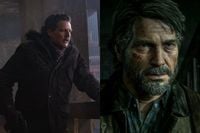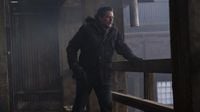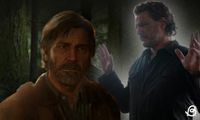The inevitable death of our beloved character, Joel, finally happened in season 2 of The Last of Us TV Show. The depiction of Joel’s death in the TLOU Part 2 video game still stands tall as one of the most controversial deaths in video game history. Joel had it coming, whether we like it or not, and everyone wondered how the showrunners would pull it off in the series. Joel hit the end of the road in The Last of Us Season 2 Episode 2, and the creators have made some major changes to how the tragic event transpired in the TV show. Spoilers Warning: This article contains spoilers for The Last of Us Part 2 game and season 2 of the TV show. So, proceed with caution.
Let me start with how the events transpired in the game first, so you can easily grasp the difference between the TLOU game and the TV show. In the game, Abby goes out to hunt Joel alone, as Owen (Abby’s close friend) has concerns over how they will get to Joel, as Jackson is a big town with a lot of people. Moreover, Owen didn’t want to risk the lives of his friends without a clear plan. Abby gets caught up in a blizzard and is also chased by a horde of zombies, but luckily gets saved by Joel, who was on a patrol with his brother Tommy. In a tense moment, Tommy reveals his identity along with his brother, Joel’s, to help the poor girl calm down after escaping from a horde. This is when Abby realizes this is the man she has been looking for all along. Abby is lucky to find Joel away from the secured town, so she lures him back to her friend’s shelter, saying they can be safe together. Joel and Tommy head back to the shelter along with Abby without being aware of what awaits them there.
When Mel introduces herself, Tommy and Joel also introduce themselves, and soon Abby’s friends realize Joel walked right into their trap without any bait. As soon as Joel starts to realize something feels wrong, Abby shoots his leg, and her friends knock out Tommy. "You stupid old man. You don’t get to rush this," says Abby. Joel’s now aware that this is his tragic end and asks Abby to get this over with quickly. But Abby, who had been waiting for this moment all along, didn’t want to rush it. She asks Mel to tourniquet Joel’s injured leg and begins to bash the old man’s head with a golf club. At this point, Ellie tracks Joel and reaches the shelter. Before Ellie can do anything to save Joel, she gets pinned down to the ground by Abby’s friends. Owen asks Abby to finish her business quickly upon finding out someone has tracked them down. Therefore, Abby bludgeons Joel to death right in front of a helpless Ellie. They also make sure to knock out Ellie and leave Wyoming, as they have now completed their revenge mission.
The showrunners played out the events leading up to Joel’s death slightly differently from the game in the TV show. For starters, Joel goes out on patrol with Dina instead of his brother in the TV show. During this, Abby triggers an infected avalanche, which hits Jackson Town. The town is also breached by the infected horde, which never happens in the game. Abby gets chased by the horde when she is on the lookout for Joel and gets saved by him, like in the game. While Tommy spills their names in the game, Abby gets to learn about Joel’s identity when Dina calls out his name in the warehouse where they were holed up. Then, Abby coaxes Joel and Dina to go to her shelter to save their lives from the horde. Upon reaching the shelter, Joel sees Jackson Town burning and tries to contact his people back in town. On the other hand, Abby urges her friends to help them initially, only to reveal that Joel is here with them. They quickly put a gun to Dina’s head and snatch away Joel’s gun. As their target is only Joel, the crew puts Dina to sleep using an injection.
Unlike in the game, Abby interrogates Joel about his actions against the Fireflies and reveals that he is the one who killed her father in a long speech (which is a callback to the game). In line with the game, Abby shoots him in his leg, tourniquets his injured leg, and proceeds to grab a golf club. Then, she hits his injured spot and moves over to smack his head next. Ellie finds Joel and Dina’s horse and goes inside the house to look for them. Unfortunately, Abby’s friends slam Ellie to the floor when she discovers a blood-soaked Joel lying on the floor, utterly powerless. When Owen asks her to end it quickly, Abby picks up a broken golf club and stabs the sharp point right into Joel’s neck, like how one kills an infected. Ellie is left barely conscious, but she crawls her way to her father figure, Joel, and hugs the fallen soul. These little changes offer new sequences; however, Joel’s death is as gruesome as ever in the game and broke my heart again. The sorrowful fate of Joel is going to haunt us forever. In the meantime, let us know if you liked the changes made in the TLOU show in the comments below.
Folks, that’s a series wrap for Pedro Pascal. Joel, one of the two protagonists of HBO’s adaptation of the hit video game The Last of Us, is dead. He was murdered by a band of ex-Fireflies in the second episode of Season 2, which aired this Sunday. The Fireflies, you might remember, are the paramilitary organization that Joel destroyed at the end of the first season. He followed through with that assault because he couldn’t stomach the idea of Ellie, the girl who has become like a daughter to him, being sacrificed in search of a cure for the rampaging fungal virus that has brought about a dire apocalypse. And in that sense, you can’t really say Joel didn’t have it coming. Still, it’s not easy watching his gruesome death, both in the game and now on the TV screen.
But that marquee moment was inevitable: Joel gets beaten into a bloodied half-consciousness with a golf club before matters finally end—in front of a restrained Ellie, no less—with a steel stake through the ear. That’s it. There is no miracle cure coming. It wasn’t all just a dream. Pascal will be on flashback duty from here on out. Those of us who played the games knew to dread this scene, although it wasn’t clear when—or even if—HBO would hold true to the source material and kill off one of its two leads. Did the sequence feel, maybe, a tad overcooked? Perhaps a bit too self-aware in its bloodletting? As if it set out to validate its own literary auspices? I wouldn’t fault you for feeling that way, because—in many ways—a commitment to careening dramatic swings has been central to The Last Of Us mythology for quite some time. Sometimes the subversion pays off beautifully. Other times? Well, your mileage may vary.
In the video game, the violence is cruel and unusual. Joel’s death occurs in the prologue—the prologue!—and it’s cued up to be the animating agent for the rest of the narrative. Joel and his brother Tommy rescue a hardened survivor, who we learn is named Abby, from a rampaging swarm of zombies. This is terrible luck, because little does Joel know, the only reason Abby is in Wyoming is to hunt him down. So, Abby lures Joel back to her hideout, brimming with her paramilitary goons, to spring her trap. Tommy is incapacitated, and Joel is beaten with a golf club, tortured with icy sadism. “You don’t get to rush this,” says Abby, when she has him in her grasp. Ellie is actively searching for Joel, who never made it back from patrol. She stumbles upon Abby’s hideout, but is discovered, knocked down, and forced to watch the last moments of Joel’s life. Her surrogate father is crumpled on the ground, nonverbal, when Abby delivers the final blow across his forehead with that golf club. One member of her party spits on Joel’s desecrated body and wishes him a speedy trip to hell.
So why does Abby want him dead? It’s simple: Joel murdered her father, who was one of the doctors operating on Ellie at the end of the first game. This is one of the key ways the TV show deviates from the video game. On the PlayStation, the sorrow at the core of Abby’s revenge is meted out carefully over hours of flashbacks—slowly exposing the context of Joel’s undoing, and all the people he had wronged. On HBO, however, all of the exposition is provided up front. Rather than Tommy (Gabriel Luna), Joel is traveling with Dina (Ellie’s brand-new girlfriend, played by Isabela Merced) when they save Abby (Kaitlyn Dever) from a horde of infected. She takes them back to the ski lodge, where the ambush occurs. Dina is subdued with an anesthetic while Abby unleashes a Bond-villain monologue identifying the precise terms of her vengeance. (Joel killed her father, upended the Fireflies, and severed one of the Earth’s only hopes for a cure, etc.) Her fellow avengers voice halting protests in the background. They want to see Joel murdered, but not like this—a stark contrast from blunted hatefulness in the mother text.
Eventually, with Ellie (Bella Ramsey) serving as a witness, Abby ends Joel’s life with a stake through the ear, using the broken-off end of the golf club. All in all, it’s a pretty faithful rendition, but it also accentuates my hang-up with The Last of Us as the show marches onward into the reedy territory of the game’s one and only sequel. When I consider how delicately the first game, and first season, unveiled its knotty morality—how it flat-out refused to provide easy answers for its difficult questions—I can’t help but feel underserved by a continuation of a story that takes great pains to remind me, at every turn, of a flat bromide we already understand implicitly: Revenge is never as satisfying as it manifests to be in our fantasies. It’s a make-or-break moment for one of HBO’s biggest hits. Will audiences decide that the show has earned Joel’s death? Or will they, like so many gamers, come to find that something is missing?
To really understand the earth-shattering impact of The Last of Us, and why the series would eventually become emboldened enough to ice its most popular character, you must also understand the contours of the video game industry. In the years before the game’s release in 2013, Naughty Dog—the studio responsible for this grimdark fungal apocalypse—had issued a trilogy of Indiana Jones–aping romps under the Uncharted name. The formula was pure camp: Uncharted starred a good-looking treasure hunter named Nathan Drake, and the rest of the cast was filled out by his inner circle of tropey sidekicks, including a femme fatale, a cigar-chomping pilot, and, eventually, a long-lost ne’er-do-well brother. It worked—those games are good—but they were also confined to their shopworn narrative aspirations. Naughty Dog set out to ape a Marvel-fied version of Hollywood, replete with writerly quips, pulp-adventure intrigue, and swashbuckling violence. The developer succeeded, but Uncharted would never be mistaken as, well, art. (Naturally, when an Uncharted movie hit theaters in 2022, it was unable to overcome the derivativeness at its heart, and was roundly panned.)
The Last of Us, then, was a genuine evolution for Naughty Dog. The game was built on a steadfast belief that with enough care and attention, a PlayStation can be capable of matching the hallowed echelons of the Hollywood canon. So the studio put us in control of Joel, a violent man with a brutal past, whose arc in the first game concludes in a hospital where he makes a horrifically selfish decision. This ending, the same one that was immortalized in the Season 1 finale of the TV adaptation, is, quite literally, my favorite scene in video game history. The script was indelible, especially Ellie’s ambiguous half-acceptance of the lie that both she and Joel have decided to live—that the operation to harvest her immunity didn’t work, and therefore neither of them are personally complicit in the ugliness of this world. But on a more meta level, the thoughtfulness of this ending signaled that something had shifted in the culture. This was a video game delivering a gut-punch, feel-bad, Godfather-esque coda. The technicolor pleasures of Uncharted had been tossed into a ditch. Naughty Dog wanted to make the game industry’s first big-screen tragedy—on the mythic scale of John Ford—and actually pulled it off.
That’s why, seven years later, I was surprised that Naughty Dog was returning to the well with a sequel game. Why bulldoze over the haunting puzzle of that perfect final scene with corroding certitude? I never really wanted to know what happened to Ellie and Joel after that. But the studio clearly had a vision, and that required the merciless destruction of the leading man in The Last of Us Part II, which was released in 2020. This, too, was a watershed moment for Naughty Dog, but only in the sense that it plunged the company into controversy. A huge number of Gamergate-aligned chuds leveraged the sequel into culture-war grievance for predictably stupid reasons. (You no longer played the game as a white man. And also, later on in the narrative, a trans character becomes central to the plot.) Really though, Joel’s death was evidence that Naughty Dog had achieved the creative cachet necessary to wield total control over its intellectual property—almost like the studio wanted to levitate above the commercial bindings of the games industry. Nintendo can’t kill Mario, Microsoft can’t kill Master Chief, but Naughty Dog is more than willing to assassinate Joel, so long as it helps make a point. And it was certainly brave, but even good-faith critics took issue with the overwhelming darkness of the twist, especially given how it’s set up as a pretense for—without a doubt—the most ruthless revenge saga ever rendered on a graphics card.
Without delving into spoilers for the rest of the second season on HBO, one of the main criticisms of The Last of Us Part II was that its thematic texture lacked sophistication. The threads it spins all inevitably arrive at the core conceits of the series—that violence begets violence, no matter how much the target deserves it—and to some, that’s not a profound enough motif to merit all of the crimes against humanity that Ellie has now set out to accomplish. Her retribution will be wide, uncompromising, and absolutely suffused with gore, but it all belies the thinness of the fiction. There are, of course, more episodes coming, but it is fair to say that our story will only grow darker from here. Ellie must achieve her vengeance, and we, the captive audience, must come along for the ride. Perhaps the TV show will manage to refine what was achieved in the video game, finding more intricate complexities in the muck of all this violence. If not, then I do wonder if newly born The Last of Us fans will eventually come around to my thinking. Maybe this story was better off leaving Joel and Ellie on that grassy knoll, where all possibilities—good and bad—stretched out into the horizon. You know what’s the real skill of the artist? Knowing when you’ve hit one out of the park.







